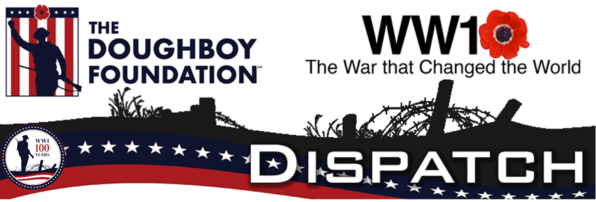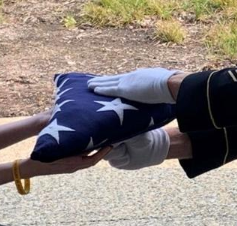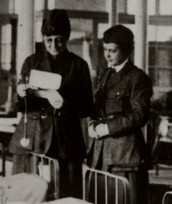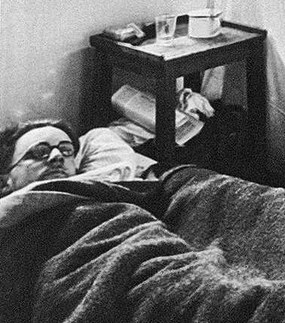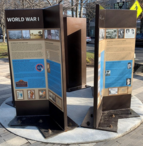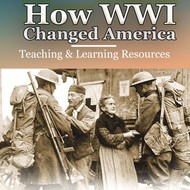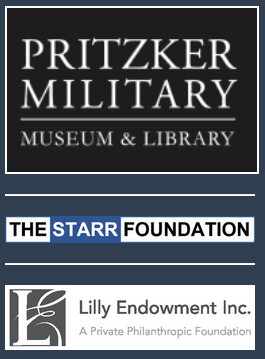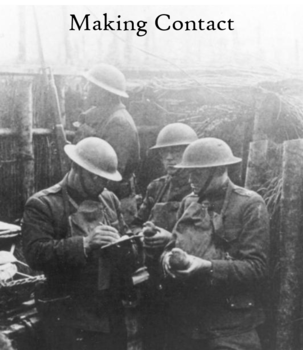|
|
|
|
September 2020
Sculptor Sabin Howard (right) supervises the loading of the first 11 clay figures of the sculpture for the National World War I Memorial into a shipping container at his studio in Englewood, NJ this month. Protected by custom-made bracing and referigation in the container, the figures are now aboard ship and on their way to Pangolin Studios in the United Kingdom, where they will be rendered into bronze using classical casting techniques. The entire sculpture is forecast for completion in 2023. For more information on the National World War I Memorial, visit ww1cc.org/memorial.
|
|
"Poppyganda: The Historical & Social Impact of a Flower" webinar October 9

Register now for our next webinar on Friday, October 9, 2020,1:00 pm EDT: "Poppyganda: The Historical & Social Impact of a Flower." The Poppy is an enduring symbol of WWI. It is an icon that embodies a century of attitudes toward that incredible conflict; however, the poppy's association with warfare predates 1914, and its legacy is still evolving today. Dr. Mathew Leonard (left) is a modern conflict archeologist at the University of Bristol in the UK - a very interesting field in its own right. In 2015 he authored "Poppyganda" which is not only a very clever book title, but also a very clever book, as he charts the history of the flower of remembrance through its history, and its role from the conflict on the western front to today.
|

We will also introduce you to the Bells of Peace National Bell Tolling program, show you how to pledge, organize, and to Toll The Bell in remembrance of those who served in WWI on the 11th hour of the 11th day of the 11th month. We will also preview our free Bells of Peace Participation App that will help you be a part of our community remembrance.
As a bonus feature, we will close the webinar the short 6 minute documentary “Immigrants and WWI” from our "How WWI Changed America" teaching and learning resources.
|

Don’t forget to sign up to participate in the “Bells of Peace” national bell tolling in remembrance of those who served and sacrificed in World War I. Click here to sign up to participate and receive info about the free “Bells of Peace” participation App.
You may also enjoy reading our daily WWI “Countdown” posts to 11 am on 11/11/2020. The “Bells of Peace” posts on Facebook, Instagram and Twitter follow the 100-day offensive that lead to the Armistice in 1918.
The new Bells of Peace Participation App will include: 7 bell sounds that will toll at 11am local time on November 11; an “Aggregator” so you can share stories, pics and plans for your “Bells of Peace” remembrance by using #BellsOfPeace. With the App you can toll manually or set it to “Toll” automatically at 11am local. The Bells App will toll, as per the tradition, 21 times, 5 seconds apart on all the phones.
Plan your remembrance now, virtual or in-person, and share ww1cc.org/bells with your friends, family and organizations!
|
Silk and Steel at National WWI Museum & Memorial highlights surprisingly important role of women’s fashion during Great War

The National WWI Museum and Memorial is pleased to invite you to itsr newest special exhibition, Silk and Steel: French Fashion, Women and WWI, open to the public as of Sept. 25.
Silk and Steel highlights the surprisingly important role of women’s fashion during WWI, especially in France. During a time of global upheaval, women were taking on new responsibilities and roles, and fashion adapted to the necessities of these new actions, scarcity of materials and ever-present societal needs.Dresses, capes, posters and accessories tell the story. Through the lens of fashion, come see this exciting exhibition that shows how the war impacted domestic life, created new businesses and provided new opportunities for women. Click here to read more about this exhibit, and how the Museum is making their facility safe for visitors during the COVID pandemic..
|
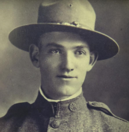
Bruce “Doc” Norton and his wife, Helen, had dug into the pile of letters once before. At their home in Stafford County, Norton typed and Helen dictated words penned from freezing trenches and decimated villages somewhere in France during World War I. But when the computer on which they’d begun their work disappeared, the project to bring the letters to life stalled. Months passed, and now it was 2018, the 100th anniversary of the end of WWI. Helen was no relation Pfc. Raymond W. Maker of Framington, Mass., a wireman who strung communication lines on the muddy battlefields of France in 1918. Nor had she ever met the man--Bruce's grandfather. But Helen wanted to see the letters brought to life. And she knew that Norton—a combat veteran and career Marine infantry officer-turned-author of military history—was just the person to make that happen. Click here to read more about how the husband and wife team turned the letters into a book, and the amazing historical discoveries they made in the process.
|
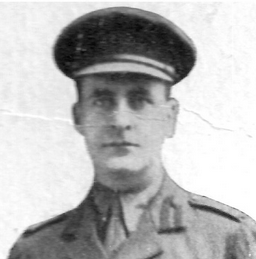
Patricia Daly-Lipe first met Msgr. William Hemmick, her mother’s only living relative, in 1961, when she was 19 and had just completed her sophomore year at Vassar College. Her mother had died the year before and Daly-Lipe wanted to meet her uncle, about whom she knew very little except that he was a Canon of St. Peter’s Basilica. The man she met "was a jovial gentleman who was friends with everyone from the Pope, to royalty, to the little boy on the street looking for food. He befriended those he met at Mass and those he knew on the street, those who lived the high-life and those who lived through and survived the ravages of war." It was not until years later, after his demise, that Daly-Lipe came to know about her uncle's extraordinary role in WWI. Click here to learn more about how Hemmick's calling led him to support those in battle, and the book that Daly-Lipe has written to tell his amazing story of service.
|

When the United States finally decided to enter World War I in 1917, there was opposition at home by those who wanted America to remain neutral in the European conflict and groups who actively opposed the draft, the first of its kind in the country. Fearing that anti-war speeches and street pamphlets would undermine the war effort, President Woodrow Wilson and Congress passed two laws, the Espionage Act of 1917 and the Sedition Act of 1918, that criminalized any “disloyal, profane, scurrilous, or abusive language” about the U.S. government or military, or any speech intended to “incite insubordination, disloyalty, mutiny, or refusal of duty.” Vestiges of these laws, viewed as some of the most egregious violations of the Constitution’s free speech protections, still linger today. Click here to learn more about the panic that spawned this legislation, and how court cases over the years eliminated most of their overreach.
|

In 1918, a novel strand of influenza killed more people than the 14th century’s Black Plague. At least 50 million people died worldwide because of that H1N1 influenza outbreak. In the middle of today’s novel coronavirus outbreak, some are turning to the conclusion of past pandemics to discern how and when life might “return to normal.” The Washington Post has received a few dozen questions from readers who want historical context for our current epidemic. But how did the deadliest pandemic ever recorded come to an end? “The 1918 flu is still with us,” said Ann Reid, the executive director of the National Center for Science Education who successfully sequenced the genetic makeup of the 1918 influenza virus in the 1990s. “It never went away.” Click here to read more, and learn how the lingering lineage of the 1918 flu can still be discerned in the current international pandemic.
|
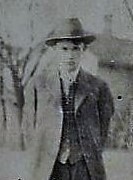
A man is only missing if he is forgotten.
Our Doughboy MIA this month is PVT Albert Louis Agnew, ASN 56619, Company A/28th Infantry Regiment/1st Division. Born October 23rd, 1895 in Keokuk, Iowa, Agnew was working in Huntington, West Virginia when he enlisted in the US Army at Ft. Thomas, Kentucky on April 2nd, 1917. He was a small man, just five feet four and a half inches tall and weighed just 125 pounds. Agnew shipped out with the first contingent of American troops sent to France on June 7th, 1917 aboard the SS Antilles and thus served with the 1st Division. He saw action in the US’s first all American effort, the Battle of Cantigny, where he was wounded by machine-gun fire and cited for bravery.
That summer of 1918, the 1st Division participated in the Battle of Soissons. There the 1stDivision was brigaded to the far left of the battle line, with the 28th Regiment just right of the French 153rd Division. On the morning of July 18th, 1918, the 28th went into action with their 2nd and 3rd Battalions in assault and the 1st Battalion in reserve. All through the 18th the 2nd and 3rd Battalions were pounded unmercifully at a place called Missy Ravine. A later write up on the battle noted how bad it was for these two battalions:
The commanders of the 2nd and 3rd Battalions decided they needed to combine forces to reach the eastern edge of the ravine. Wading elsewhere through the waist deep swamp, the combined force made it up the eastern bank of Missy Ravine and captured all the guns by 9:30 am. While still under heavy machine-gun fire, the men formed a consolidated line 300 yd (274 m) east of Breuil. Having lost all of its officers, 2nd Battalion was reorganized into five small platoons plus a machine gun platoon, each commanded by a sergeant.
The next morning the 2nd and 3rd tried to attack again at 4:00 am but were stopped cold. In order to kick start the drive in the 28th’s sector, the fresh 1st Battalion was now called up to lead the attack in. This battalion included PVT Albert Agnew. When the fighting ended on July 19th, The 28th Infantry Regiment had struggled as far as Ploisy Ravine and still maintained contact with the French 153rd Division on their left. That afternoon of the 20th the 28th attacked again, but were held virtually in place by intense German machine gun and artillery fire and it was there that PVT Agnew was killed. The battle would not wrap up (an Allied victory) until the 23rd. Soissons was a turning point; from then on until the end of the war, the Germans facing the American troops were in retreat.
Following the war, PVT Agnew’s battlefield grave was never located. Then, on February 13th, 1925, two sets of remains were found buried in the same hole near the Commune of Ploisy. The first set of remains were identified as those of PVT Dewitt Facundus of Company D/28th Infantry, KIA on July 20th, 1918. The other set however went unidentified and were designated as U-1661. The collar discs on these remains indicated the man had been in Company A/28th Infantry, but there were no other identifiers. A check of the lists of unlocated for Company A of the 28th Infantry in that area and time frame of battle showed one man missing – PVT Albert Agnew. However, no dental records existed for PVT Agnew and without any way to ID the remains found one way or the other, they were laid to rest at the Aisne-Marne Cemetery at Belleau Wood as Unknown. PVT Agnew’s case remained open until investigations were suspended on August 20th, 1932 and the case permanently closed. PVT Agnew’s name was later carved into the Wall of the Missing at the Aisne-Marne Cemetery chapel.
The likelihood of the remains designated U-1661 being those of Albert Agnew are very high, but at this time there is no determination that can be made.
Wouldn’t you like to be part of the important work we do in accounting for the missing US service personnel from The Great War? Well sure you would! Why not consider a tax-deductible donation to Doughboy MIA? Just hop on over to www.ww1cc.org/mia and make your donation today, and know you did your part.
Remember: a man is only missing if he is forgotten.
|

Inspired by the iconic image of a U.S. Doughboy, you can wear your American pride with this Made in the USA ¼ zipper fleece sweatshirt. An informal term for a member of the U.S. Army or Marine Corps, “Doughboys” especially used to refer to the American Expeditionary Forces in World War One. Largely comprised of young men who had dropped out of school to join the army, this poignant lone silhouette of a soldier in trench warfare serves as a reminder of those who sacrificed so much one century ago.
Sweatshirt features: Navy with white Doughboy embroidery. 80% cotton/20% polyester, 9.5 Oz. High quality heavy weight pre-shrunk fabric. Sweatshirt has ¼ zip pullover with cadet collar and silver metal zipper. Ribbed cuffs and waistband with spandex. Cover-seamed arm holes. Mens’ sizes available Small and Medium. Proceeds from the sale of this item will help to fund the building of the national World War One Memorial in Washington, D.C.
A Certificate of Authenticity as Official Merchandise of the United States World War One Centennial is included.
This and many other items are available as Official Merchandise of the United States World War One Centennial.
|
|
|
|
|

Submitted by: K.C. Picard-Krone {State World War 1 historian}
Ernest L Wrentmore, Jr. was born around 1904. Ernest Wrentmore served in World War 1 with the United States Army. The enlistment was in 1917 and the service was completed in 1919.
Story of Service
Ernest L. Wrentmore, Jr. was the 12 year (10 months) old son of Maude Vinora and Dr. Ernest Wrentmore Sr of West Farmingham, Ohio who decided on the morning of September 28, 1917 to skip school and enlist in the Army. A big, strapping boy who easily passed for a young man on the brink of manhood, Ernest was five foot six in his stocking feet, and weighed over 145 pounds. He easily passed the physicals and no one questioned the vital statistics he scribbled down on the enlistment documents: Henry E. Monroe of Gettysburg, Pennsylvania, age 18.
His distraught family became aware of his disappearance when Ernest didn’t return home that night and they started a search of the area. Finally a clue to his whereabouts surfaced eight months later when the Army mailed an overseas card to their home address in May. By this time he had already made the perilous trek through the German submarine infested waters to the Western Front in France.
|

|
|
|
|

